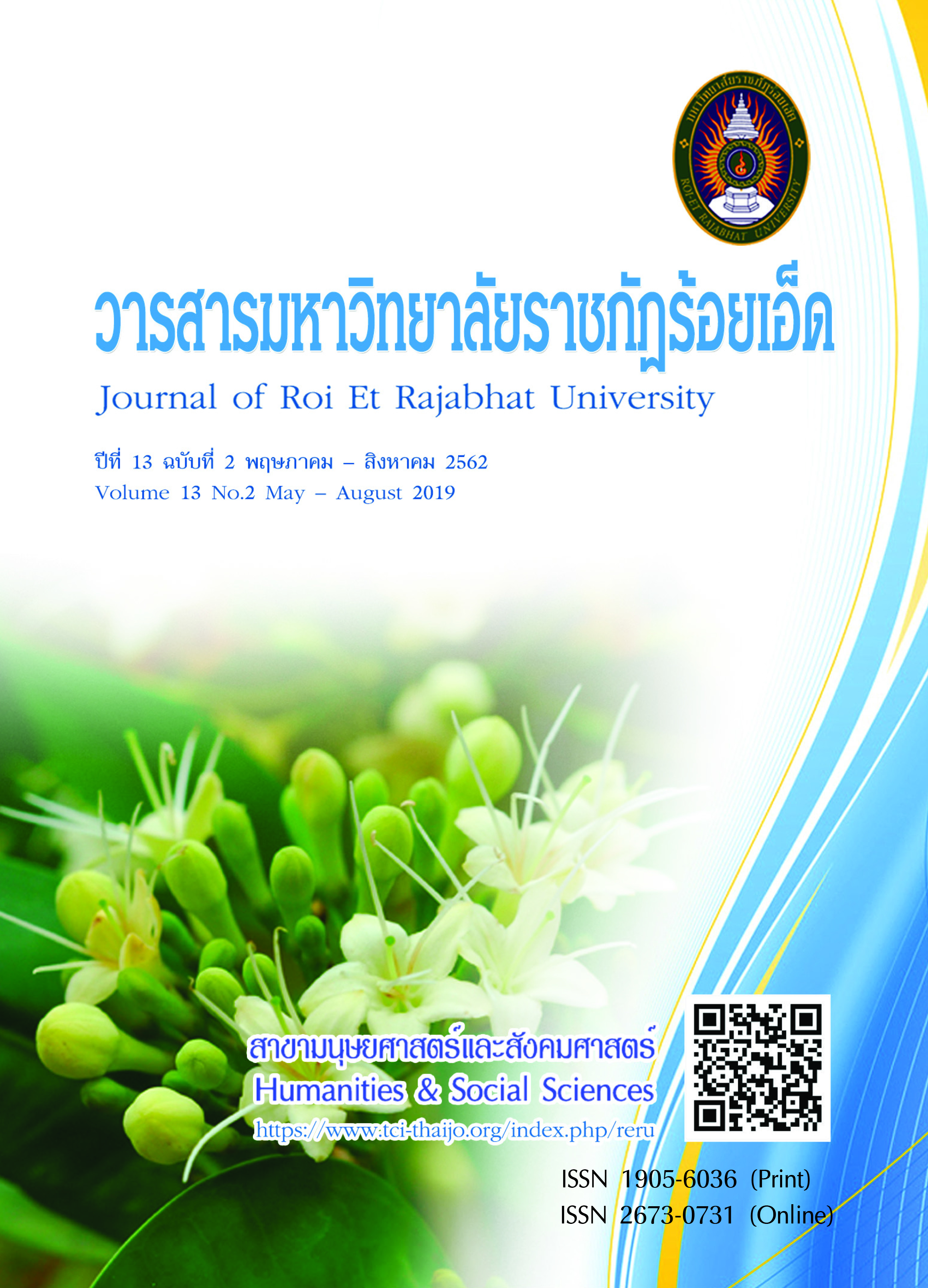Using Semantic Mapping in Teaching English Reading Skills of Thai EFL Learners
Keywords:
Semantic Mapping, Teaching English Reading Skills, EFLAbstract
This article aims at explaining the meaning and relevant factors including procedure in teaching English skills for the Thai EFL learners through the use of semantic mapping. Reading is essential and undeniably one of the most important skills since it helps develop an all–rounded, in-depth person; however, reading skills may be difficult for those who learn English as a foreign language because they are probably unfamiliar with it. As a result, the learners of English as a foreign language must understand the vocabulary and various sentence patterns of English very well in order to grasp the main point of text being read; therefore, semantic mapping is one teaching method that helps simplify the reading skill. The elements of the semantic mapping should be thought of as geometric shapes and the message of the main idea or details of the story are arrows which represent the directions and connect the maim idea. This is a way to help learners see the relationship of the true message; moreover, it helps the students to organize the details into groups according to the topics. Using semantic mapping, the learner-centered learning process is helpful because it asks the students to participate in building the map of the idea. Consequently, the procedure of semantic mapping is a method which will help learners read English with better understanding and enable them to grasp the main idea of the text by making effective connections of the whole story systematically.
References
ประเทืองสุข ยังเสถียร. (2549). ผลสัมฤทธิ์ทางการเรียนภาษาอังกฤษของนักเรียนชั้นมัธยมศึกษาปีที่ 6 ที่เรียนหลักสูตรภาษาอังกฤษ พุทธศักราช 2544 ในโรงเรียนรัฐบาล เขตกรุงเทพมหานคร. วิทยานิพนธ์ ศิลปศาสตรหาบัณฑิต สาขาวิชาการสอนภาษาอังกฤษ. กรุงเทพฯ: มหาวิทยาลัยเกษตรศาสตร์.
พิสิทธิ์ จิตติสุขพงษ์. (2550). การศึกษาผลสัมพันธ์ในการอ่านภาษาอังกฤษโดยใช้แผนภูมิความหมายของนักศึกษาชั้นปีที่ 1 มหาวิทยาลัยเกษมบัณฑิต. กรุงเทพฯ: มหาวิทยาลัยเกษมบัณฑิต.
มณีรัตน์ สุภโชติรัตน์. (2552). อ่านเป็น : เรียนเก่ง สอนเก่ง. กรุงเทพฯ: นานมีบุ๊คส์พับลิเคชั่นส์.
รุ่งฤดี แผลงศร.(2556). การจัดการเรียนการสอนทักษะการอ่านภาษาไทยระดับสูง สำหรับผู้เรียนชาวต่างประเทศ โดยวิธีการใช้ผังมโนภาพ The Teaching of Thai Reading Skills to Foreign Learners through Mapping. วารสารมนุษยศาสตร์ ปริทรรศน์, 34(1), 83-90.
วิลาวัณย์ สมมาตร. (2543). ความสามารถในการอ่านภาษาอังกฤษขั้นตีความของนิสิตชั้นปีที่ 2 คณะศึกษาศาสตร์ มหาวิทยาลัยเกษตรศาสตร์. วิทยานิพนธ์ ศิลปศาสตรมหาบัณฑิต สาขาวิชาการสอนภาษาอังกฤษ. กรุงเทพฯ:มหาวิทยาลัยเกษตรศาสตร์.
สุภัทรา อักษราพุเคราะห์. (2532). การสอนทักษะทางภาษาและวัฒนธรรม. กรุงเทพฯ: โรงพิมพ์จุฬาลงกรณ์มหาวิทยาลัย.
สมุทร เซ็นเชาวนิช. (2549). เทคนิคการอ่านภาษาอังกฤษเพื่อความเข้าใจ (พิมพ์ครั้งที่ 11). กรุงเทพฯ: มหาวิทยาลัยธรรมศาสตร์.
อรุณี วิริยะจิตรา. (2532). การเรียนการสอนภาษาเพื่อการสื่อสาร. กรุงเทพฯ: โรงพิมพ์อักษรเจริญทัศน์.
Conley, M.W. (1995). Content Reading Instruction: A Communicative Approach (2nd ed). New York: McGraw-Hill.
Morris, A. & Dore, S.N. (1984). Learning to Learn from Text. Singapore: Addison-Wesley.
Oxenden, C. & Seligson, P. (2008). English File: Book I. New York: Oxford University Press.
Rattanavich, S. (1987). The Effects of Using top-Level Structure Instructional Modules and Traditional Teaching Method in Teaching English to Thai Students. Project Report SEAMEO RELC Fellowship Grant.
Sinatra, R.C.; Stahl–Gemake, J. & Morgan, N.W. (1996). Using Semantic Mapping after reading to Organize and Write Original Discourse. The Reading Teacher, 38(1), 4-12.
Valette, R.M. & Disick, R.S. (1972). Modern Language Performance Objectives and Individualization: A Handbook. New York: McGraw-Hill.
Zaid, D.R. (1995). Story Maps Improve Comprehension. The Reading Teacher, 39(5), 705-712.
Downloads
Published
How to Cite
Issue
Section
License
บทความที่ได้รับการตีพิมพ์เป็นลิขสิทธิ์ของวารสารมหาวิทยาลัยราชภัฎร้อยเอ็ด
ข้อความที่ปรากฏในบทความแต่ละเรื่องในวารสารวิชาการเล่มนี้เป็นความคิดเห็นส่วนตัวของผู้เขียนแต่ละท่านไม่เกี่ยวข้องกับมหาวิทยาลัยราชภัฎร้อยเอ็ด และคณาจารย์ท่านอื่นๆในมหาวิทยาลัยฯ แต่อย่างใด ความรับผิดชอบองค์ประกอบทั้งหมดของบทความแต่ละเรื่องเป็นของผู้เขียนแต่ละท่าน หากมีความผิดพลาดใดๆ ผู้เขียนแต่ละท่านจะรับผิดชอบบทความของตนเองแต่ผู้เดียว





